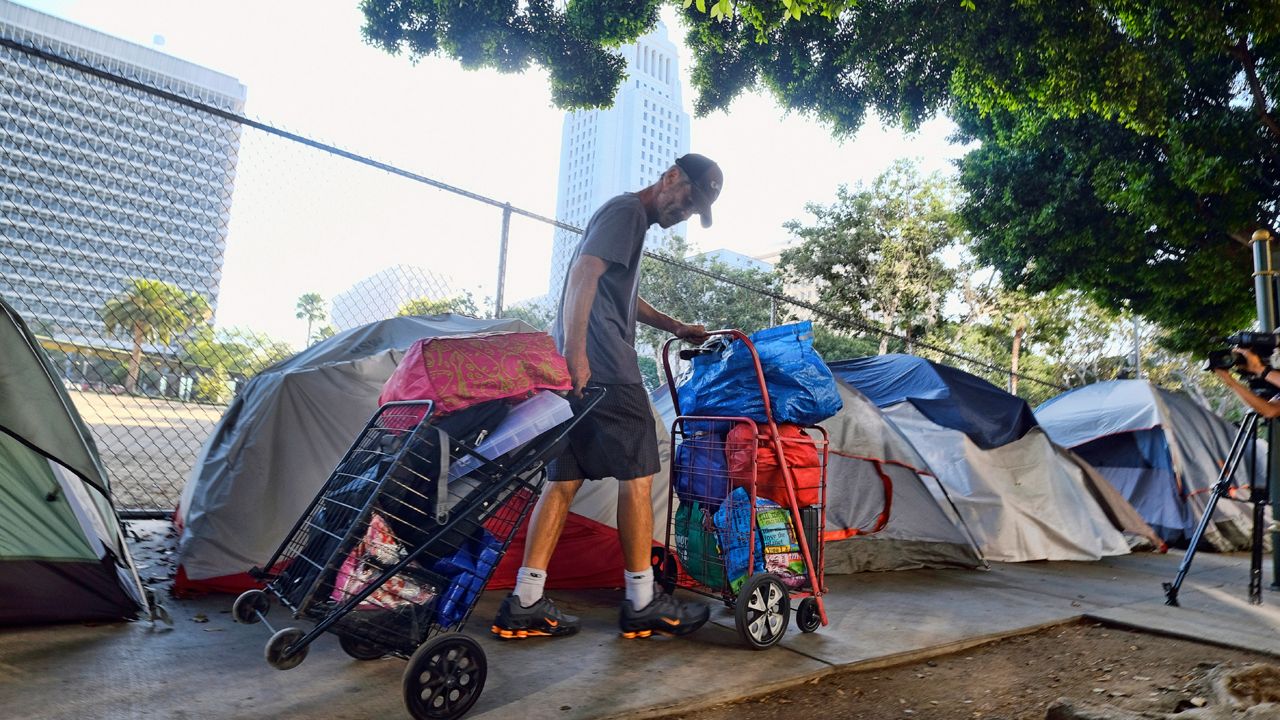LOS ANGELES (CNS) — A hearing to reconsider an ordinance banning homeless encampments within 500 feet of schools and day care centers is set for July 27 after the Los Angeles City Council failed to give the proposal its unanimous approval.
The council voted 10-1 in favor of the ordinance, with Councilman Mike Bonin dissenting. Since the vote was not unanimous, the matter will return to the council for a second vote following the summer recess.
Friday's vote came during a sometimes-raucous meeting that was repeatedly interrupted by shouting from the audience.
The ordinance is an amendment to the city’s sweeping law regulating the location of homeless encampments. Municipal Code 41.18 prohibits sitting, sleeping, lying or otherwise obstructing the public right of way in several areas of the city.
Those areas include within 2 feet of any fire hydrant or fire plug; within 5 feet of any operational or utilizable entrance or exit; within 10 feet of a loading dock or driveway; in a manner that interferes with any activity for which the city has issued a permit or restricts accessible passage as required by the Americans with Disabilities Act; or anywhere within a street, including bike paths.
The law already protects the public right of way within 500 feet of “sensitive” facilities such as schools, day care facilities, parks and libraries — but only if each specific location is designated by the council for enforcement.
The amendment given tentative approval Friday, and approved last week by the council’s Homelessness and Poverty Committee, is a blanket ban on encampments within 500 feet of all schools.
Numerous speakers appeared at the council meeting to speak on both sides of the issue, with opponents blasting the move as a criminalization of homelessness. One speaker called it an example of the city’s “cruelty” against the homeless population.
“This isn’t about fixing homelessness, it’s about aesthetics,” one opponent said.
Others called it a vast expansion of an already restrictive ordinance restricting the movements of a homeless population in need of services and housing.
But supporters of the ordinance, including some parents and school workers, said the issue is a matter of safety for children who must walk by encampments on their way to classes. One parent and school worker told the council it “will help reduce the risk that my students, their families and my colleagues face on a daily basis because of the criminal activity that has been happening.”
A school principal told the council the encampments expose students to “unsafe, unsanitary conditions.”
Bonin opposed the measure, suggesting that it will just move the homeless around and adding, “Making it less visible doesn’t make it go away.”
“In some ways, we actually make it worse,” he said. “By displacing people, we actually disconnect people” from housing and other services.
Councilmen Mitch O’Farrell and Paul Krekorian, however, spoke in favor of the ordinance, dismissing allegations by opponents that the council is only trying to cover up the homelessness issue rather than address it through housing and services.
Multiple opponents of the measure began shouting from the audience as the councilmen spoke, bringing the meeting to a halt while Council President Nury Martinez issued warnings, then ordered at least three people to be ejected from the council chamber. O’Farrell and Krekorian, both visibly angered, said the conduct exemplified the “bullying” tactics of some organizations. O’Farrell accused them of spreading “disinformation.”
“You can protest all you want, but it doesn’t change the truth,” O’Farrell said. “The truth is the city is engaged in housing people. It is our focus.”
Krekorian added, “These bullies who want to disrupt our business do not want to acknowledge that kind of success.”
“We need to move forward with common-sense solutions,” he said. “We are not criminalizing homelessness at all with this change. We are taking actions necessary to restore some degree of sanity and civility to our streets, and at the very same time, we are protecting the young people of this city.”
Councilman Joe Buscaino proposed the idea of an encampment ban near schools last year, but it never gained traction. The issue was revived earlier this year, in part due to the urging of Los Angeles Unified School District Superintendent Alberto Carvalho, who said teachers, principals and parents have expressed concerns about homeless encampments near campuses.
“I’ve seen elementary schools with conditions that none of us as parents would find acceptable for children. Individuals with mental illness, some of them absolutely unclothed, shouting profanities in the listening ear of children,” Carvalho told the council previously.
Buscaino, who sits on the Homelessness and Poverty Committee, said last week that approving the amendment will “ensure the most sacred places among us, our playgrounds and schools, are safe.”
The city ordinance already in place also prohibits encampments and sleeping within:
- Up to 500 feet of a designated overpass, underpass, freeway ramp, tunnel, bridge, pedestrian bridge, subway, wash or spreading ground, railroad track or where lodging unsheltered or in tents is unhealthy, unsafe and incompatible with safe passage
- Up to 1,000 feet of a facility opened after Jan. 1, 2018 that provides shelter, safe sleeping, safe parking or navigation centers for persons experiencing homelessness
- The ordinance also allows the city to prevent encampments for a period of no longer than one year in areas that are deemed an ongoing threat to public health or safety, including due to
- Death or serious bodily injury of any person at the location due to a hazardous condition
- Repeated serious or violent crimes or threats of serious or violent crimes, including human trafficking
- Fires at the location
People who violate the ordinance face an infraction or citation, but “a person who willfully resists, delays or obstructs a city employee from enforcing this section or who willfully refuses to comply after being requested to do so by an authorized city employee” can face higher fines and a misdemeanor charge, according to the ordinance.



